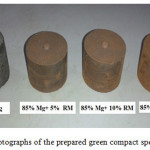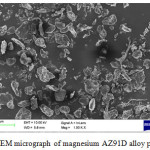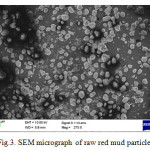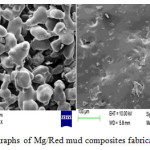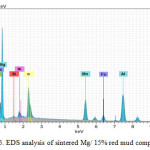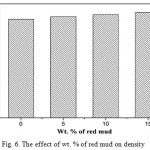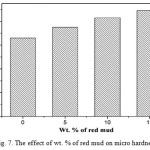Synthesis and Characterization of Sintered AZ91D Magnesium Matrix Composites Reinforced with Red Mud Particles
D. Rajamani1*, A. Tamilarasan2, Balasubramanian Esakki1 and K. Ananthakumar3
1Centre for Autonomous System Research, Department of Mechanical Engineering, Vel Tech Dr.RR and Dr.SR Technical University, Avadi, Chennai- 600062, India
2Centre for Advanced Manufacturing and Materials Processing (CAMMP), Department of Mechanical Engineering, Sri Chandrasekharendra Saraswathi Vishwa Mahavidyalaya, Kanchipuram-631561, India
3Metallurgical and Materials Engineering Laboratory, Department of Mechanical Engineering, Vel Tech Dr.RR and Dr.SR Technical University, Avadi, Chennai- 600062, India.
Corresponding Author Email: rajamanitamil1991@gmail.com
DOI : http://dx.doi.org/10.13005/msri/130205
Article Publishing History
Article Received on : 5-Oct-2016
Article Accepted on : 14-Nov-2016
Article Published : 14 Nov 2016
Plagiarism Check: Yes
Article Metrics
ABSTRACT:
Magnesium AZ91D alloy is reinforced with red mud particles, is the by-product of alumina which is extracted from refining of bauxite throughbayer process to fabricate low cost novel composite by powder metallurgy technique. Reinforcement ratio was varied from 0% to 15% whereas size of the particles were kept as 30µm.The microstructure and mechanical properties such as density and microhardness of the composite were evaluated. Microstructural characterization of the sintered composite revealed a near uniform distribution of the red mud particulates with magnesium alloy metal matrix.The test results indicated that the increase in weight % of red mud particles significantly enhances the mechanical propertiesof the composite.
KEYWORDS:
Magnesium; Microstructure; Mechanical properties; Sintering; Powder metallurgy; Red mud
Copy the following to cite this article:
Rajamani D, Tamilarasan A, Esakki B, Ananthakumar K. Synthesis and Characterization of Sintered AZ91D Magnesium Matrix Composites Reinforced with Red Mud Particles. Mat.Sci.Res.India;13(2)
|
Copy the following to cite this URL:
Rajamani D, Tamilarasan A, Esakki B, Ananthakumar K. Synthesis and Characterization of Sintered AZ91D Magnesium Matrix Composites Reinforced with Red Mud Particles. Mat.Sci.Res.India;13(2). Available from: http://www.materialsciencejournal.org/?p=4547
|
Introduction
Magnesium alloys have been gained much attention in automotive and electronic industries due to their light weight, excellent damping capacity, castability, and machinability.1 However, insufficient high temperature strength and poor corrosion resistance of the magnesium alloys limit their extensive applications.2 The need for high performance and light-weight materials in aerospace and aeronautical industries has become increasingly urgent in recent years, which lead to extensive research in processing magnesium matrix composites with cost-effective technologies.3
Magnesium metal matrix composites (MMCs) reinforced with ceramic particles have a great potential to be applied in aerospace and automobile industries because of their high specific tensile strength and modulus, as well as their wear resistance.4,5 There are several methods to fabricate reinforced Mg MMCs including stir casting, squeeze casting, powder metallurgy, infiltration and mechanical alloying.6,10 Among these, powder metallurgy (P/M) technique is probably used to fabricate reinforced Mg composites. The P/M technique can attain a more uniform distribution of particulates in the metal matrix with or without less excessive reactions between the matrix and reinforcements and the composites can fabricate from powders without passing through a fully melting state.11 Red mud, an industrial waste residue formed after caustic digestion of bauxite ores during the production of alumina.12 Itcontains considerable amount of alumina, caustic soda, ferric oxide, titanium and other minor valuable constituents.13 Hence, it can be act as a good reinforcement in metal matrix composite to enhance the physical and mechanical properties.
This study focuses on synthesis and characterization of AZ91D Mg alloy reinforced with red mud which have been prepared by powder metallurgy technique.Reinforcement levels are varied from 0-15 wt. % of matrix material. The microstructure and mechanical behaviour such as density and hardness of sintered composite specimens have been investigated.
Materials and Processing
In this experiment, atomized pure magnesium AZ91D powders (99.9% purity, ~80 µm) and red mud particulates (~105 µm) collected from the alumina extraction industries through bayer process were used as matrix material and ceramic reinforcement phase, respectively. The chemical composition of red mud was analysed and shown in Table 1. The powder blends with designed composition of 0, 5, 10, and 15 vol. % red mud were mixed in a ball mill for 4 h to achieve proper quality mixtures.
Table 1: Chemical composition of Red mud
|
Elements
|
Fe2O3
|
Al2O3
|
SiO2
|
Na2O
|
CaO
|
TiO2
|
Others
|
|
Weight %
|
26.41
|
18.94
|
8.52
|
4.75
|
21.84
|
7.4
|
12.14
|
The mixed powder is then pressed into cylindrical compacts (40 mm diameter and about 60 mm height) in a vertical hydraulic compression press at pressure ranging from 16 to 19 MPa. The photograph of compacted cylindrical green composites is presented in Fig.1.The density of the compacted powder is directly proportional to the amount of applied pressure, hence, the compact pressure is maintained for all composition of Mg-red mud composite is about 82±2 theoretical density.Finally, compacted green compacts are sintered in an argon supplied electric muffle furnace in the temperature range of 823 K for a period of 60 min and they have allowed to be cooled down to room temperature in the furnace.
Figure 1: Photographs of the prepared green compact specimens
Results and Discussion
Microstructure and mechanical characterization of sintered composites is carried out using metallographic examinations with scanning electron microscope (SEM) at operating voltages of below 20 kV, atomic force microscope (AFM) analysis, density, wear rate, and hardness measurements. All SEM specimens were sputter coated with gold-palladium to avoid charging.
Surface morphological analysis
Fig. 2 & 3 shows a general SEM view of the raw Mg and red mud powder particles. It has a broad range of particle size, from 20 to 150 µm and an irregular shape with a rough surface.
Figure 2: SEM micrograph of magnesium AZ91D alloy particles
Figure 3: SEM micrograph of raw red mud particles
Fig.4 show the SEM micrographs of sintered specimens. The general arrangements of magnesium molecules and reinforcements of the Mg alloys are faintly fusedtogether at points of contact and some individual particles can also been identified in Fig 4a.It is seen that the distribution of red mud particles in magnesium matrix is noticeably uniform. Fig.4b shows the top surface of sintered specimen. It indicates the smooth surface with uniform distribution of reinforcement in sintered composite. It also indicates the crack free and well-polished surface. This may be attributed due to the proper distribution of pressure during compaction. However, some pores attributed in the specimen. This is attributed due to the increase in volume fraction of reinforcement.14,15
Figure 4: (a-b). SEM micrographs of Mg/Red mud composites fabricated by powder metallurgy
In order to conform the presence of reinforcement in sintered specimen, EDS analysis was done over a particular region of the composite surface. In the figure, Mg, Al, Zn, Mn, and oxygen peaks are observed. The EDS analysis confirms the existence of major components presented in Table 1. The oxygen peak is observed due to the presence of oxygen molecules in extracted red mud in the form of Fe2O3, CaO and SiO2.From the above analysis it has been asserted that red mud reinforcement in the form of Si, Al, and Mn particles are successfully incorporated in the Mg matrix composites.
Figure 5: EDS analysis of sintered Mg/ 15% red mud composite
Mechanical properties
Density
The theoretical density of Mg matrix composite was calculated using the rule of mixtures.16 The actual density for the pure Mg compact and composite were calculated using Archimedes principle. The sintered sample was weighted in air (Wa), then suspended in distilled water and weighted again (Ww). The actual density of the composite samples is calculated using the following formula:
pa = Wa/(Wa – Wa) Χ pw (1)
Where pa is the actual density, Wa is the mass of the cylindrical sample in air, Ww is the mass in distilled water, and pw is the density of distilled water. The effect of red mud reinforcement on the density of sintered samples as a function of Wt. % of red mud is shown in Fig 6. As can be seen from the figure, the density increases with increase in Wt. % of red mud reinforcement.The addition of 15 Wt. % red mud increases the density from 1.83 g/cm3 to 1.94 g/cm3. The increasing density will simultaneously improves the mechanical properties.
Figure 6: The effect of wt. % of red mud on density
Microhardness
The hardness of the red mud reinforced composites was evaluated using Vickers hardness tester. The applied load on specimens is 3 kg and dwell time is considered as 15 s. An average of three readings is taken for hardness value of each specimen. Fig 7. shows the effect of red mud on micro hardness of the samples with 0-15 wt. % of red mud particles. The hardness of the composite increases with increase in reinforcement level and the maximum hardness of 89 VHN is observed in 15 wt. % of red mud.This is due to the hard reinforcement particles offered resistance to surface plastic deformation of composites during the indentation and the red mudparticles render their inherent property of hardness to the soft matrix which significantly increases the hardness value.
Figure 7: The effect of wt. % of red mud on micro hardness
Conclusion
- Magnesium metal matrix composites (MMCs) reinforced with 5, 10, and 15 wt. % red mud particles were successfully fabricated by powder metallurgy technique. The EDM analysis indicated that oxygen existed at the interface between the red mud particulate and Mg matrix due to the presence of Fe2O3, CaO and SiO2in reinforcement.
- SEM images of sintered composites indicates the uniform distribution of reinforcement particles in the matrix. As compared with pure Mg specimen, the mechanical properties such as density and micro hardness of Mg MMCs reinforced with 15 wt. % red mud particles were increased by 5.67 % and 23.59%, respectively. Hence the increase in reinforcement will considerably increases the mechanical strength.
References
- Hu H., Yu A., Li N., Allison J. E. Mater. Manuf. Process. 2003;18:687.
CrossRef
- Ye H. Z.,Liu X. Y. J. Mater. Sci. 2004;39:6153.
CrossRef
- Chen L., Yao Y., Acta, Metall. Sin. (Engl. Lett.). 2014;27(5):762–774.
- Hassan S. F., Gupat M. Mater. Res. Bull. 2002;37:377–389.
CrossRef
- Jiang Q. C., Wang H. Y., Wang J. G., Q.F. Guan, C.L. Xu, Mater. Lett. 2003;57:2580– 2583.
CrossRef
- Saravanan R. A., Surappa M. K. Mater. Sci. Eng. 2000;A276:108–116.
CrossRef
- Vaidya A. R., Lewandowski J. J. Mater. Sci. Eng. A. 1996;220:85–92.
CrossRef
- Ferkel H., Mordike B.L. Mater. Sci. Eng. 2001;A298:193–199.
CrossRef
- Thakur S. K., Dhindaw B. K. Wear. 2001;247:191–201.
CrossRef
- Lu L., Thong K. K., Gupta M. Compos. Sci. Technol. 2003;63:627–632.
CrossRef
- Wang H. Y., Jiang Q. C., Wang Y., Ma B. X., Zhao F. Mater. Lett. 2004;58:3509–3513.
CrossRef
- Rashad A. M. Constr. and Build. Mater. 2013;41:751–765.
CrossRef
- Paramguru R. K., Rath P. C., Misra V. N. Miner. Process. Extr. Metall. Rev. 2005;26(1):1−29.
CrossRef
- Rizkalla H. L., Abdulwahed A. J. Mater. Process. Technol. 1996;56:398–403.
CrossRef
- Nai S. M. L.,Gupta M. Compos. Struct. 2002;57:227–233.
CrossRef
- Merola M. Mater. Sci. Eng., A Struct. Mater. Prop. Microstruct. Process. 1996;214:181–185.
CrossRef

This work is licensed under a Creative Commons Attribution 4.0 International License.
 Material Science Research India An International Peer Reviewed Research Journal
Material Science Research India An International Peer Reviewed Research Journal

